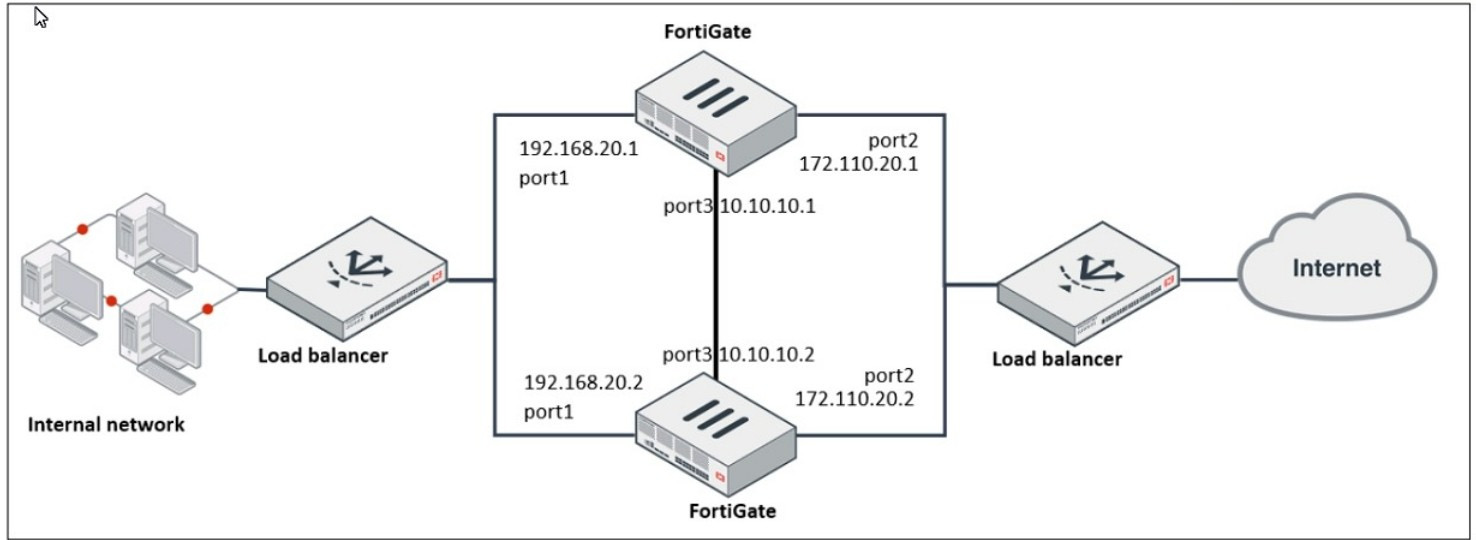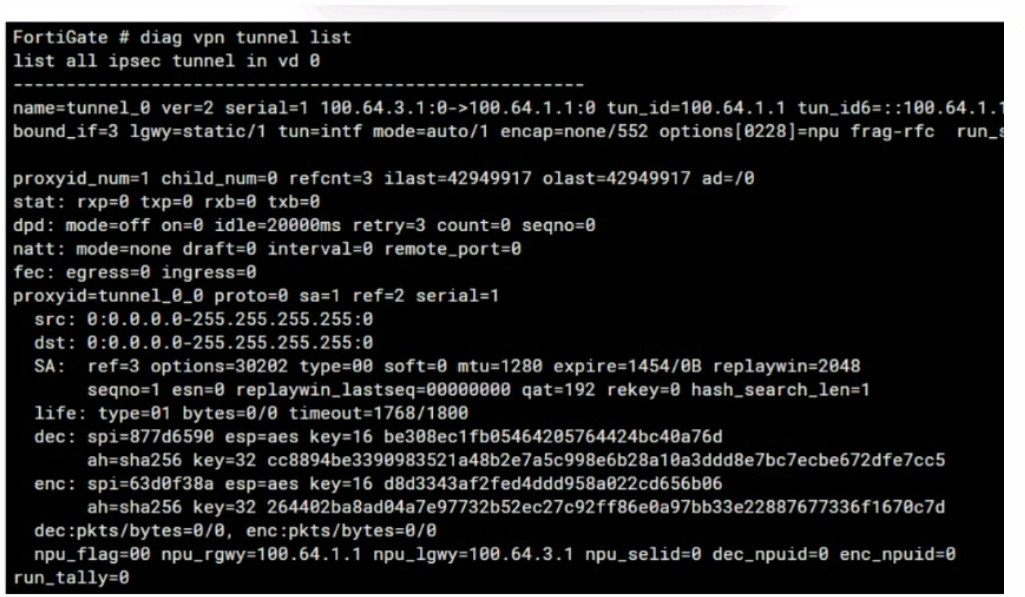Exam Details
Exam Code
:NSE7_EFW-7.2Exam Name
:Fortinet NSE 7 - Enterprise Firewall 7.2Certification
:Fortinet CertificationsVendor
:FortinetTotal Questions
:80 Q&AsLast Updated
:Aug 06, 2025
Fortinet Fortinet Certifications NSE7_EFW-7.2 Questions & Answers
-
Question 1:
Refer to the exhibit, which shows a network diagram.

Which protocol should you use to configure the FortiGate cluster?
A. FGCP in active-passive mode
B. OFGSP
C. VRRP
D. FGCP in active-active mode
-
Question 2:
Which two statements about bfd are true? (Choose two)
A. It can support neighbor only over the next hop in BGP
B. You can disable it at the protocol level
C. It works for OSPF and BGP
D. You must configure n globally only
-
Question 3:
Exhibit.

Refer to the exhibit, which shows a partial touting table
What two concisions can you draw from the corresponding FortiGate configuration? (Choose two.)
A. IPSec Tunnel aggregation is configured
B. net-device is enabled in the tunnel IPSec phase 1 configuration
C. OSPI is configured to run over IPSec.
D. add-route is disabled in the tunnel IPSec phase 1 configuration.
-
Question 4:
Refer to the exhibit, which shows a custom signature.

Which two modifications must you apply to the configuration of this custom signature so that you can save it on FortiGate? (Choose two.)
A. Add severity.
B. Add attack_id.
C. Ensure that the header syntax is F-SBID.
D. Start options with --.
-
Question 5:
Which two statements about the neighbor-group command are true? (Choose two.)
A. You can configure it on the GUI.
B. It applies common settings in an OSPF area.
C. It is combined with the neighbor-range parameter.
D. You can apply it in Internal BGP (IBGP) and External BGP (EBGP).
-
Question 6:
Winch two statements about ADVPN are true? (Choose two)
A. auto-discovery receiver must be set to enable on the Spokes.
B. Spoke to-spoke traffic never goes through the hub
C. lt supports NAI for on-demand tunnels
D. Routing is configured by enabling add-advpn-route
-
Question 7:
Which two statements about the Security fabric are true? (Choose two.)
A. FortiGate uses the FortiTelemetry protocol to communicate with FortiAnatyzer.
B. Only the root FortiGate sends logs to FortiAnalyzer
C. Only FortiGate devices with configuration-sync receive and synchronize global CMDB objects that the toot FortiGate sends
D. Only the root FortiGate collects network topology information and forwards it to FortiAnalyzer
-
Question 8:
Refer to the exhibit, which shows a network diagram.

Which IPsec phase 2 configuration should you impalement so that only one remote site is connected at any time?
A. Set route-overlap to allow.
B. Set single-source to enable
C. Set route-overlap to either use--new or use-old
D. Set net-device to enable
-
Question 9:
Refer to the exhibit, which contains information about an IPsec VPN tunnel.

What two conclusions can you draw from the command output? (Choose two.)
A. Dead peer detection is set to enable.
B. The IKE version is 2.
C. Both IPsec SAs are loaded on the kernel.
D. Forward error correction in phase 2 is set to enable.
-
Question 10:
You want to block access to the website ww.eicar.org using a custom IPS signature.
Which custom IPS signature should you configure?

A. Option A
B. Option B
C. Option C
D. Option D
Related Exams:
FCP_FAZ_AD-7.4
FCP - FortiAnalyzer 7.4 AdministratorFCP_FGT_AD-7.4
FCP - FortiGate 7.4 AdministratorFCP_FGT_AD-7.6
FortiGate 7.6 Administrator FCP_FGT_AD-7.6FCP_WCS_AD-7.4
FCP - AWS Cloud Security 7.4 AdministratorFCSS_EFW_AD-7.4
FCSS - Enterprise Firewall 7.4 AdministratorFCSS_NST_SE-7.4
FCSS - Network Security 7.4 Support EngineerFCSS_SASE_AD-24
FCSS - FortiSASE 24 AdministratorNSE4_FGT-5.6
Fortinet NSE 4 - FortiOS 5.6NSE4_FGT-6.0
Fortinet NSE 4 - FortiOS 6.0NSE4_FGT-6.4
Fortinet NSE 4 - FortiOS 6.4
Tips on How to Prepare for the Exams
Nowadays, the certification exams become more and more important and required by more and more enterprises when applying for a job. But how to prepare for the exam effectively? How to prepare for the exam in a short time with less efforts? How to get a ideal result and how to find the most reliable resources? Here on Vcedump.com, you will find all the answers. Vcedump.com provide not only Fortinet exam questions, answers and explanations but also complete assistance on your exam preparation and certification application. If you are confused on your NSE7_EFW-7.2 exam preparations and Fortinet certification application, do not hesitate to visit our Vcedump.com to find your solutions here.